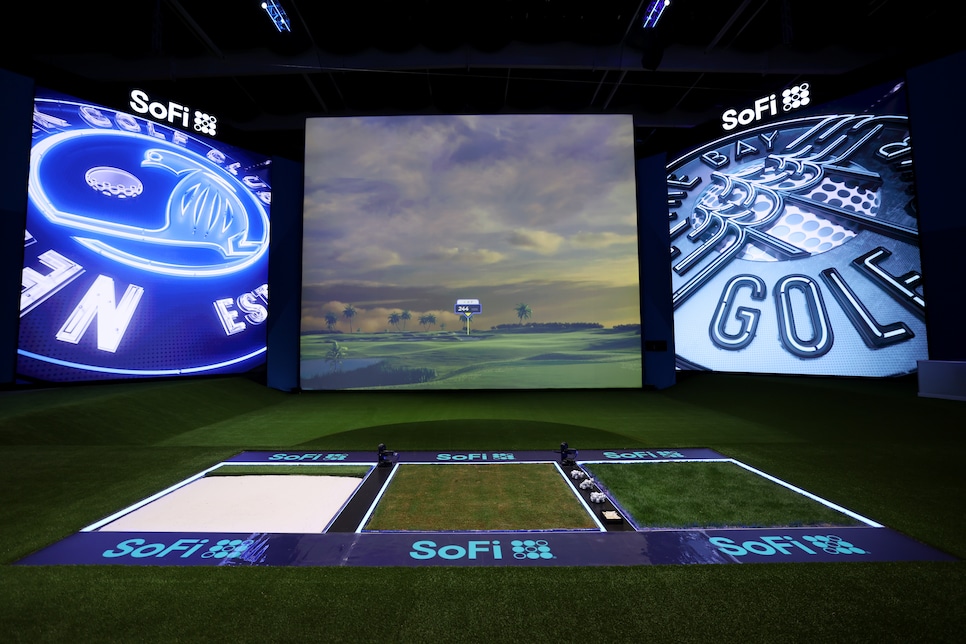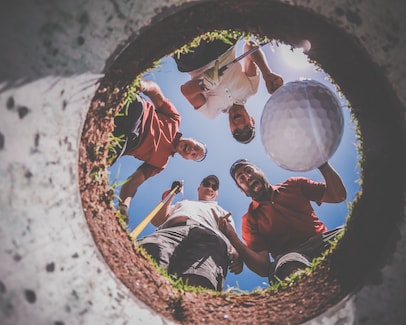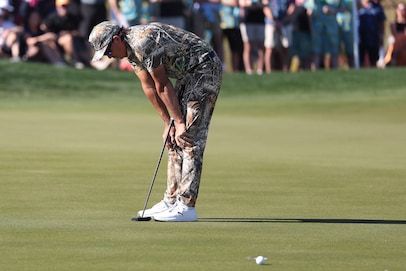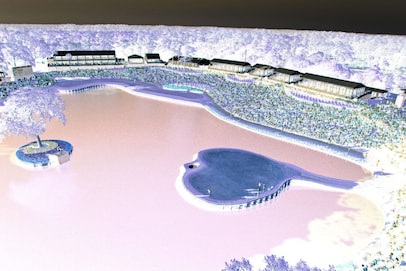The TGL’s inaugural season has come and gone, and there’s one takeaway we can probably all agree on: We’d pay good money to give the SoFi Center’s big screen a spin. Reportedly built at a cost of $50 million, the TGL home is tricked out with a 64-feet by 46-feet simulator screen, 3,800 square feet of putting space and stadium seating for up to 1,500 fans. Not too shabby.
Sadly, there are no plans in the works to make the facility open to the public between now and the start of the 2026 TGL season. Instead, then, everyday golfers like us will have to settle for less highfalutin simulators to grab some practice time until the local course has tee times available for the season. Conveniently, at least, there are plenty of those places available these days; there just so happens to one that’s a quick drive/walk away.
As golf obsessives (and golf snobs), we have a lot of thoughts on how simulators have improved over the years but some still are asking the same basic query: Are simulators really beneficial to working on your game? We understand it’s not a true 18 holes, but it’s still pretty chilly out in some part of the country, so isn’t it’s OK to take what we can get? We put out these questions to the Golf Digest staff to get their thoughts and, well, they had a lot of them.
Sam Weinman, Digital Editorial Director: Golf simulators are like shooting baskets on your driveway hoop. You could spend all your time lamenting that it’s not quite basketball. But it’s decidedly more basketball than watching Netflix. There are only a few scenarios in which I would opt for playing golf in a simulator over a real golf course, among them: hurricanes, blizzards and maybe green aerations. Otherwise, real golf is always better. Simulators can’t account for awkward stances or sketchy lies, or that gnawing feeling of teeing off after just missing a three-footer on the previous green. But simulators can still be helpful in bridging the gap between seasons and allow us to access our inner golf nerds. I have never uttered the words “apex” or “smash factor” during an actual round, but these are useful concepts to explore when refining my swing so it’s ready for the golf course—provided they’re not aerating.
Ron Kaspriske, Senior Editor of Instruction: Having spent many winters hitting on simulators, watching the technology improve, I have some advice for how to use one the right way. First, the don’t: Don’t chase speed and distance numbers. You can crank your swing speed up 10 miles per hour on a simulator, but when you get back on the course, you’ll automatically slow back down to the numbers that your brain says will keep the ball in play. So, all you’re doing when chasing numbers indoors is setting up your body for pain and injuries. It’s fun to crank it up, but don’t make that your goal.
Now, here are the two best ways to use a sim. 1) Work on swing path and clubface orientation. Most average players will be shocked to see how much they swing across their target line on an out-to-in path, especially with the longer clubs. Make it a game to see how much you can “flip the script” and swing in to out (shown as a positive number on the sim, most likely). Couple that with a square clubface, and you’re actually grooving a really good golf swing without even realizing it. 2) Pay attention to smash factor. A 95-mph driver swing that strikes the ball centerface will go just as far as a 100-mph swing when the ball is struck out on the toe. You’ll soon realize your best swings are unhurried and produce plenty of power.

Brennan Asplen/TGL
MORE: 8 tips for working on your golf swing in a simulator—and why it’s better than the range
Luke Hooten, Social Media Coordinator: As a New York City-based golfer, simulators have saved my game. I swing on a sim two to three times a week and have no doubt in my mind that it has taken my game to a new level. I have such a better understanding of my yardages and swing tendencies, and I believe that it translates very well to the course. I find that most golfers struggle to know how far they actually hit the ball, but being able to consistently see my numbers on a simulator has solved that problem for me. Sure, it’ll never replicate the real thing, but it’s the next best thing.
Christopher Powers, Staff Writer: No, they do not. In fact, after a short 20 minute simulator session at the Golf Digest Christmas party a few years back, I’m confident in saying they actively f—ed my game. I despise simulator golf, to the point I’ve literally “passed” on it when it’s suggested by buddies as a winter activity. No thanks, I’d rather sit on my couch and order in with the wife than take turns taking swings in a claustrophobic “hitting bay” and not even being able to seriously chip and putt, AKA “scoring,” AKA the best part of golf. If it ain’t the great outdoors, I ain’t coming out of the great indoors. Plus, I’m a big believer in putting the clubs away December-February and really, really appreciating the season when it returns in March and enjoying every second of it up until Black Friday in November. There are other ways to get your “fix” in the cold months, too. Short weekend trip to Florida/the south, tailoring your workouts specifically to golf, working on your grip on the same couch I mentioned before, re-watching old Masters final rounds on YouTube, etc. Fake golf has absolutely zero appeal to me. “But you can drink!” Yes, you can … at home.
More Golf Debates Answered  golf debate answered Does a hole-in-one count on a par-3 course? Here’s your final answer
golf debate answered Does a hole-in-one count on a par-3 course? Here’s your final answer  golf debate answered Where’s the line when it comes to the clothes tour pros wear? Let’s figure this out
golf debate answered Where’s the line when it comes to the clothes tour pros wear? Let’s figure this out  golf debate answered Is TPC Sawgrass a true championship course or just a tricked-up TPC track?
golf debate answered Is TPC Sawgrass a true championship course or just a tricked-up TPC track?
Keely Levins, Contributing Writer: As a golfer in New England, simulators have been helpful to me in that they provide opportunities to swing a club when I otherwise wouldn’t. I’ve played in a simulator league, which was a nice way to make sure I not only swung a club but tried to do so with a little pressure, throughout the winter. I’ve spent some time on our club’s simulator just setting it to range mode and hitting balls to keep my swing from feeling too foreign once spring arrives. As far as actually improving my game, I don’t think my time on simulators has resulted in any real improvement. Partly because I haven’t taken the simulator seriously enough as a tool for improvement—I could be using it to dial in wedge distances, for example—and partly because my game needs some short-game work that you can’t get done on a simulator. For me right now, it’s a helpful way to stay familiar with my swing when the courses aren’t open. But it’s not helping my game in a big way.
Greg Gottfried, Web Producer: As a relatively new golfer (at least compared with the die-hards surrounding me), I’ve found my simulator experiences lacking and less than helpful. Shots that feel good go nowhere and drives that should be trash fly with ease. Now, I’m sure part of this is an inability to hit it consistently and an ever-changing form, but I’ve yet to find a simulator that mimics what it’s like on the course … or even at a range. The numbers are nice and all, but I found myself all out of whack after testing my wares virtually. Everything gets thrown off, which was probably going to happen at some point, but it feels like a bit of a waste, especially with the potentially exorbitant prices. In my experience, the simulators throw me off more than anything. And it, unfortunately, doesn’t take that much.
E. Michael Johnson, Equipment Editor: First, let’s start with reality: Simulator golf is nothing like actual golf (sorry TGL). Hitting off mats is nothing like hitting off turf and there’s not the fear factor of sending one off the map off the tee. That said, I have found that it can help your game. In winter climes, it assists in keeping the rust off and late-season swing thoughts intact. I also found it useful in producing a feel for those pesky 40-yard pitch shots. So how much does using the simulator help? In a game where every little advantage is needed, enough to where it’s worth using it.
Joel Beall, Senior Writer: Simulators don’t just hurt. They betray, with calculated malice. It sounds fun—a few swings at virtual Pebble Beach while winter drags outside, technology serving you. But that slight draw you’ve spent years perfecting suddenly morphs into a vicious slice. No explanation. No warning. It just is. So you tinker and adjust, fighting against invisible forces and everything you thought you knew. You spend hours trying to fix what was never broken, misled by digital lies. When you escape to the actual driving range up the street, your correction has overcompensated. That slice is now a hook so violent it threatens neighboring fairways. All the while, the simulator has collected information on you. Your patterns, your weaknesses, your breaking points—all harvested while you chase perfection in their make-believe world. You never see that your obsession with this stupid game has left you vulnerable. The revolution isn’t coming with metallic footsteps and laser fire like it did in the “Terminator” or “Matrix” movies (at least I assume, I still haven’t watched them). It’s already here, disguised as something for you to enjoy. When you finally look up from your stance, at your wits end to whether the ball is going left or right, you’ll find a world transformed while you were distracted by fake grass and simulated wind. Your swing won’t save you then.
This article was originally published on golfdigest.com

